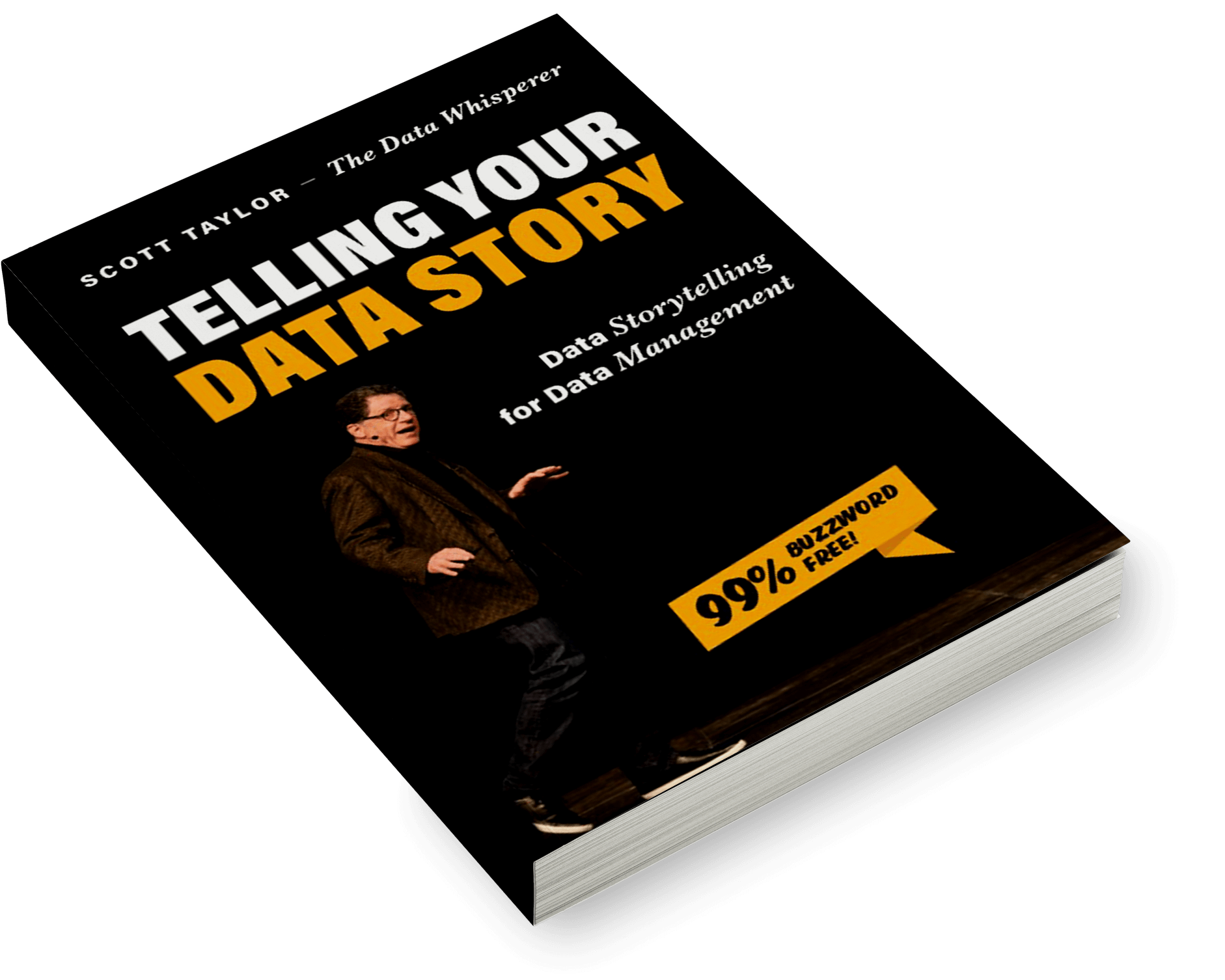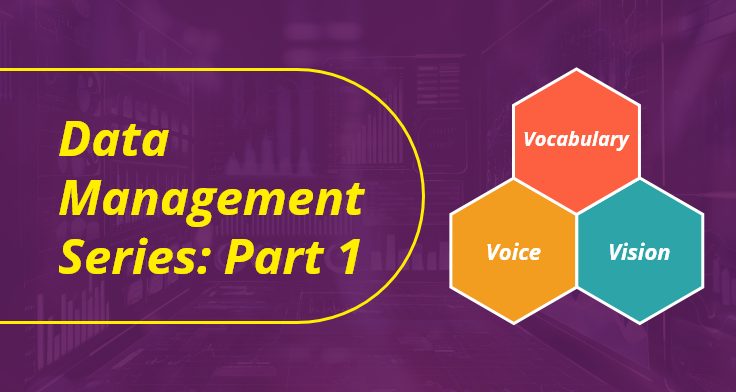To help BRIDGE THE STORY GAP between Data and The Business, we are excited to share excerpts from the book ‘TELLING YOUR DATA STORY – Data Storytelling for Data Management’ by our knowledge partner, Scott Taylor, The Data Whisperer.
Data management is one of the most important, and overlooked, competencies at most enterprises. It is an unsung hero behind many business initiatives, providing the groundwork for data-driven decision making that ultimately results in faster, more accurate insights and better ROI.
Everything We Do Today Turns To Data
As your business and business processes go from analog to digital, everything you do turns to data. Yet, enterprises of all sizes are struggling to make sense of it all, lost in a sea of numbers without any reference point to accurately gauge performance. Instead of delivering incredible value, much of this data is creating a lot of chaos. Finding value in data is elusive and frustrating. How do you determine the truth and derive meaning from all that data to grow, improve, and protect your business?
What is Your Business Case for Data?
I suggest it is the very business you are in. I assume your business purpose is to deliver value to your relationships through your brands, at scale. Delivering value to relationships through your brands has always been at the core of business. To do it at scale takes technology. Technology requires data. Data requires data management, and without a proper understanding of data management best practices, you’ll be overwhelmed with information that isn’t helping you in any tangible way.
Where Do You Begin?
When you try to determine the truth and derive meaning from data, where do you begin? I begin with the simplest, most important data of all. It is the data about your relationships and your brands. Your relationships: customer, vendor, partner, prospect, supplier, citizen, patient, client, or consumer. How reliable is your data about those relationships? Duplicates? Confusing hierarchies? Missing classifications and segments? Conflicting geographies and markets? What about the data on your brands? Products, services, offerings, SKUs, banners, locations, materials, ingredients, and concepts? That might be a bit of a mess too. Data management is, at least partially, about establishing a source of reliable data, and ensuring that all who need it are granted access to the data they need. It’s about maintaining the usability, integrity, and security of data, and the data you have on those who add value to your business is the number one priority.
Data management is one of the most important, and overlooked, competencies at most enterprises. It is an unsung hero behind many business initiatives. Your company must fund and support data management as a systematic, consistent, fundamental part of your business. Not a project, but a program. Not a tactical exercise, but a strategic imperative.
Overcoming Internal Resistance
If you are like most companies, you have multiple systems and workflows that support separate departments and divisions. Your relationship and brand data get created with differing definitions that lack the internal standards that data governance could provide.
You may already know how to fix your data, but your business leaders ignore your advice. Your business has no interest in your beautiful data “quality” dashboards. Your stakeholders don’t care about data “hygiene.” When presenting endlessly on your data maturity assessment, you start to sound adolescent, due entirely to the lexicon you use not matching what’s expected of such a key business component. You fail to gain a commitment to support your data management efforts. Things remain as they were before, with minimal use of accurate, vetted data.
Engaging Business Leaders with the 3Vs of Data Management
To better leverage the value of data management across an enterprise, the essentials must first be understood. When you explain it to the business, they are nodding “yes” on the outside and nodding off on the inside. To win your leaders over, you need to tell a better story.
The type of story you need to construct, in this scenario, is a pitch. You are selling the idea of data management. In solving your selling problem, you need to work on what I refer to (with a knowing wink to Big Data) as The 3Vs of Data Management Storytelling – Vocabulary, Voice, and Vision.
In most cases, the Vocabulary is confusing, the Voice is discordant and the Vision is blurred. When communicating to executive leadership, skip the technical details, the feature functionality, and the reference architecture and focus on:
- Vocabulary – Establish an Accessible Vocabulary
- Voice – Harmonize to a Common Voice
- Vision – Illuminate the Business Vision
Data Storytelling in Practice
If you are a data leader or practitioner, you are already well-versed in data management, data governance, master data, reference data, metadata, business glossaries, data dictionaries, data catalogs, taxonomies, ontologies, hierarchies, identifiers, classification schemas, and beyond. To spread your message, however, you need to make it simple, and data storytelling is the key to doing exactly that.
You may already understand the programming and technical requirements. How to code, how to architect, and how to implement these data management solutions. If you do, then you know more about that than I do. But what you may learn from me is how to explain the value of those things to your business stakeholders. These stakeholders aren’t interested in hearing about the numbers, they’re interested in the meaning behind these data points. They want to know the key takeaways, not the day-to-day fluctuations, and data storytelling helps you to package these ideas in an easily understood way.
Articulating Value Through Data Storytelling To Gain Support & Funding
You probably need more funding to manage data because it doesn’t seem important enough to your board of directors. It is not the cool stuff. It is not the sexy stuff that everybody’s talking about. If you want funding, if you want support, if you want stakeholder engagement, you must be able to articulate the value of your proposition for data management. That is true for every business proposition, but for Data Leaders, it can be particularly challenging, as data is generally thought of as a tertiary factor rather than the primary factor.
Data and technology are rooted in hard skills: coding, stewardship, governance, architecture, and process design. Articulating the value and getting support often takes soft skills like storytelling. It is useful because it taps into what makes us all human. Data management storytelling is evangelism. You need to get people to believe in what you are saying, even if they cannot see it. You need them to practice what you will preach.
Business stakeholders need an accessible way to understand the fundamentals of what makes data important – free of buzz words, technical descriptions, and hyped-up urgency.
In part 2 of this series, we will explore two kinds of Data Storytelling: stories WITH data and stories ABOUT data. Stay tuned!

Excerpted with permission from Technics Publications from ‘TELLING YOUR DATA STORY – Data Storytelling for Data Management’ by Scott Taylor, The Data Whisperer & Infocepts Partner.
Recent Blogs

The Future of Supply Chains Is AI-Driven—Is Your Business Ready to Embrace the Change?
July 2, 2025

What Retail Media Can Learn from Instacart’s AI Strategy
June 24, 2025

Beyond Chatbots: How Agentic AI Is Automating High-Stakes Business Decisions
June 11, 2025

From Batch to Real-Time: The Future of Data Distribution Using Databricks Delta Sharing
June 4, 2025


